Abstract
In the past few years, higher education across the world transitioned to different online platforms where virtual classrooms were set, following national guidelines during the COVID-19 pandemic. This paper analyses qualitative data from first-year students in architecture from a higher education institution in the UK and draws on lecturers’ reflective observations of teaching during the COVID-19 pandemic. The findings of this research provide some critical considerations for the long-term impact of the virtual design studio on architectural design pedagogy and teaching methods in first-year studies. This research found that technology integration enabled innovative design methods, improved digital literacy, and enhanced collaboration in first-year architectural education. While online learning met learning objectives, it posed challenges like social isolation and motivation issues. The study underscores the importance of investigating virtual design studios and technology integration in early architectural education, offering opportunities for curriculum development and future research. These findings have broad relevance for educators teaching first-year architecture students globally.
1. Introduction
In the past few years, higher education institutions have become very familiar with the necessity to adapt to online teaching and learning [1]. During the COVID-19 pandemic, higher education across the world transitioned to different online platforms where virtual classrooms and lecture rooms were set [2,3]. In the UK, the period of the widespread transition to virtual learning environments in higher education institutions coincides with the period of two government-enforced lockdowns and work-from-home restrictions that were introduced during the pandemic throughout 2020 and early 2021 and one further local and university-introduced lockdown in early 2022.
Early architectural education is synonymous with the development of soft skills, such as time management, collaboration, creative thinking and digital literacy, as well as practical skills, such as sketching, orthographic drawings and model making. Traditionally, creative design practices are developed in the design studio, which is often a physical shared space supported by a strong studio culture and informal peer-to-peer learning. Within architecture studies, studio culture is recognised and considered as fundamental in the process of a student’s learning and a “constructive process of dialogue with peers and tutors, at best a means of preparing for practice through working in groups, both formalised timetabled contact with academics and peers and the serendipity of informal dialogue and collaborative exchange” [4] (p. 46). These exchanges provide students with an enhanced learning experience, crucial in enabling active participation and interaction amongst peers within the shared space of the studio.
Through analysis of qualitative data from a higher education institution in the UK, we reflect on the architecture studies during the period of the COVID-19 pandemic in the past two years—since March 2020. In this article, we specifically explore the impact of virtual design studios on first-year architecture studies and students’ observations on the studio culture in such a setting. The article follows a group of students who began their architectural education online in September 2020 and then transitioned to a studio-based learning environment in September 2021. These students had no previous experience of university life and transitioned from school to university during the period of the pandemic. The surveyed student cohort temporarily went back online in January 2022 and then transitioned for the second time to studio-based learning in February 2022.
These dynamic transitions between virtual and face-to-face teaching over a short period of time highlight the complexities of the transformation of higher education during the COVID-19 pandemic. Furthermore, our research specifically explores the theme of ‘nurturing studio culture’ in a virtual learning environment during the first year of architectural education.
2. Research Questions and Methodology
This paper is contextualised by a discussion on ‘studio culture’ in architectural education and curriculum development, with specific attention to online learning and the first year of studies in architecture. As part of this research, we question: what happens to studio culture, design thinking and skills development for first-year architecture students during virtual teaching?
The research presented in this paper draws on the lecturers’ reflective observations of teaching during the COVID-19 pandemic to provide a new perspective on the role of a virtual design studio culture in curriculum development in architecture in higher education. Furthermore, the research and findings presented in this article reflect on qualitative data from online questionnaires shared with first-year architecture students who transitioned from a virtual to a physical design studio after one academic year on two occasions. The first questionnaire was shared with the students at the end of the 2020/21 academic year to reflect on a virtual design studio during the period of the global pandemic and sought responses from students in an ARB and RIBA-validated architecture school. The second questionnaire, to the same cohort of eighteen students, was shared mid-way through the 2021/22 academic year and during conventional design studio and face-to-face design studio teaching.
The questionnaires, shared with the students online, consisted mostly of statements to which the students could strongly agree or strongly disagree upon their reflection of individual and group work, perceptions on the studio culture, peer-to-peer learning and the challenges for feedback sessions in both studio contexts. At the end of the surveys, open-ended questions encouraged students to further expand on their experiences on these themes. These questions with limited text focused on the challenges of online as well as challenges for face-to-face learning. In relation to the first theme, we asked the students about the biggest challenges in setting a studio within their own room, what aspects of individual and group work did they enjoy the most and what is the biggest challenge for online studio teaching. In relation to the second theme, similarly, we asked the students what the biggest challenges for face-to-face teaching are and if they can compare their personal experiences of studio culture through online and face-to-face studio and design teaching. This qualitative data was analysed through collation into themes that outline the most common trends amongst the responses received. This research thus provides some critical considerations for the long-term impact of the virtual design studio on the architectural design pedagogy, teaching methods and curriculum development in first-year studies. This research also contributes to our understanding of the transformative qualities of the architecture design studio in the last two years. First-year studies are fundamental, as they help young adults transition from school to university and prepare students for academic readiness. First-year studies are also an explorative period where students begin to engage with architecture whilst developing core practical skills. Within such a framework, this research also posits that the early application of digital technologies for teaching design thinking and skills acquisition in the first year of architectural education yields positive results.
The objectives of this research are to:
Reflect on ‘design studio culture’ for first-year students in architecture, in particular within the context of virtual teaching during the COVID-19 pandemic, and to highlight some considerations on how to nurture it in the future.
Explore considerations for curriculum development and integration of digital technologies from the first year in architectural studies to enhance the acquisition of design skills, such as surveying, sketching, orthographic drawing, physical modelling, presenting and teamwork.
These objectives highlight the importance of understanding the educational and pedagogical approaches as part of the design studio.
3. Context of Architectural Education in Higher Education Institutions
3.1. Studio Culture
The architecture ‘studio’ is fundamental in higher education institutions where “the informality of the studio as a workplace is uniquely conducive to the design learning process” [4] (p. 30). The pedagogical methods associated with the architecture studio are under constant development; it is a place for empirical explorations, experimentation and project-based learning for the students [5]. The architecture studio is also a place for the development of a new way of analytic and synthetic thinking, culture and professional values [6,7,8]. Studio surfaces are places where students post inspirations, precedents, concepts and drafts [9]. This unique learning space is also a place where students experience “physical, temporal and cultural immersion” [10] (p. 1250). The physical and material embodiment of the studio is defined by the use of drawing boards, cutting surfaces and, more recently, digital equipment such as laptops, scanners and photography equipment. The design studio is a “practical and unstructured” place where students “learn by doing, rather than through any formal instruction” [11]. Within this space, regular design feedback from tutors happens, and peer-to-peer learning supports both formal learning and informal reflections on design proposals [12]. The social value of the architecture studio is also a significant attribute of architecture programmes, and many consider the studio as a place where “community” is created, enduring confidence and motivation amongst peers. The studio is a place where students feel connected to peers, and enhanced studio culture has therefore been at the centre of architectural education. Creating an environment that is collaborative is crucial for the studio culture, and setting it up from the first year can have a positive impact on the further education experience of the students.
3.2. Conventional, Virtual, or Blended Design Studio
Within the conventional design studio (CDS), identified as “a structured, systematic learning and designing process by being in a dedicated fixed built structure” [13], the physical place where peers work together is implicit, and students are at the centre of its setting. The attachment to place and to the physical environment has an influence on the development of the architect. The sense of community that is cultivated within the dynamic learning environment of the architecture studio contributes to the exchanges of knowledge amongst peers. Previous research on blending a conventional studio, virtual design studio and live projects found it fostered opportunities for collaborative learning whilst promoting different levels of motivation and engagement [14]. The global pandemic impacted and will continue to impact other architecture studio cultures, extending the boundaries of the physical space beyond the physical space of the classroom. It demanded a pedagogical shift, causing architecture courses to go solely online or take a blended approach, depending on the national health and safety policies. Transitioning from face-to-face to virtual forms of education through the use of multiple platforms in the past two years also provided an opportunity to reflect on the role of the design studio in architectural education. Nevertheless, the setting of the virtual design studio (VDS) in higher education has had challenges, identified as “behaviour correlations, such as ‘listening-in’ (viewing other students’ work) and student success, as well as behaviour shifts from ‘passive’ to ‘active’ engagement” [15]. Research also reflects on student preferences that form diverse education formats that impact student satisfaction [16] and a “fall in student satisfaction after the move to remote learning” [17] (p. 1173).
Reflecting on architectural education from the last two years includes integration of technology-based educational models and investigation of blended learning approaches in architectural education [18]. The changing contexts of the studio culture in the past two years are also linked to the conditions imposed by the global pandemic and were supported by the evolving use of technology in the architecture studio, also providing an opportunity to “reconsider the emerging phenomenon of virtual design studio” [19] (p. 263).
In the past few years, the virtual design studio also provided opportunities for continuous dialogue and engagement among students and integration of digital technologies into the curriculum [20]. These educational models will help faculty to develop visions of post-COVID-19 architectural education, which includes the integration of technology and online delivery of the teaching–learning continuum.
4. Lecturers’ Reflective Observations of Curriculum Development during the COVID-19 Pandemic
4.1. Setting up a Virtual Design Studio
During the pandemic, we had to set up a VDS to facilitate a studio culture as a place where students can engage in both formal learning and informal reflections through peer-to-peer dialogues. Since March 2020, and within the rapidly changing environment of lockdowns and work-from-home national guidance, the method of delivery of higher education transitioned to virtual classrooms (Figure 1). The role of the architecture studio and the collaborative pedagogical models attributed to it were transformed as well. In this section, we discuss how the lecturers adapted the curriculum and developed new pedagogical approaches through the integration of technology to cultivate an online studio culture (both formally and informally).
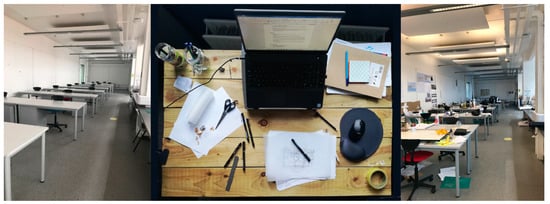
Figure 1.
The transformation of the design studio in the past two years.
As discussed, the application of digital technologies to architectural education was necessary during the virtual teaching. Lecturers considered ways to cultivate a ‘studio culture’ online and determined that it was necessary to create a supportive framework for various forms of communication and levels of formality. With this in mind, three main online tools were adopted for teaching and learning, including Canvas, Teams and Miro. Canvas is an online tool made compulsory by the university in previous years; it is predominantly used by staff to publish course material and by students to access material and formally submit coursework. The platform can also be used for various discussion forums, chats and announcements. However, these additional tools are rarely used for informal interactions. During the pandemic, Canvas continued to be used in the same way as it previously was—primarily as a repository for course material at a university level and formal assessment.
During the period of national lockdowns, Microsoft Teams became a valuable tool to facilitate weekly design feedback sessions and to help students communicate and collaborate (share information) amongst their peer groups in a semi-structured way. Teams was introduced from the beginning of the pandemic and became the “norm” during teaching in this period. Teams provided opportunities to develop the curriculum and explore alternative teaching methods, helping continuous dialogue and engagement. For example, Teams was utilised to organise an “academic buddy” system providing a time and virtual space for students to contact each other and discuss their projects informally and outside of scheduled weekly design feedback sessions. Therefore, Canvas and Teams were employed in parallel: Canvas to formally share coursework material and Teams to aid file sharing (amongst students), screen sharing during feedback sessions and peer-to-peer discussions.
In addition, student representatives set up a Whatsapp group and informally chatted amongst themselves. Lecturers observed this communication at a distance and noted that, at times, it appeared helpful in communicating with the group.
One of the challenges during the pandemic was to search for a solution for sharing visual information online and to enable free-hand sketching and discussion in the same way that we would have done when conducting feedback sessions in person in the conventional design studio. Miro proved useful and soon became an integral part of all design modules in architecture. The software helped the lecturers to visually structure the desired design process of project assignments, thus also helping the students to understand project expectations and develop design proposals, and it also provided opportunities for collaboration in a shared virtual space (Figure 2). Architecture students shared their work with the rest of the year group through the software, and they were required to regularly upload preparation material on Miro in advance of the weekly feedback sessions. Miro was also used during design charrettes when students would actively develop design ideas collaboratively during a live online workshop.
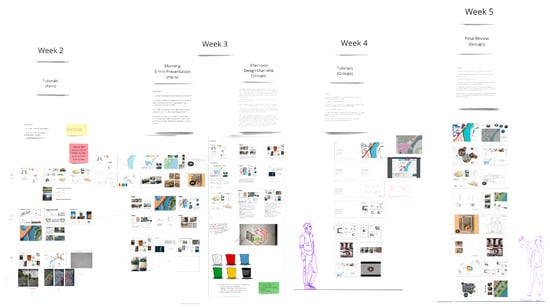
Figure 2.
First-year collaborative design project using Miro (Winter 2021).
As the teaching of architecture had to transition to a virtual space, students were required to set up a ‘home studio.’ During the period of the lockdown, teaching was not permitted in the physical studio space provided by the university, but students were permitted to use the studio space for independent study. Therefore, most students set up their home/virtual studio, which was essential to their engagement with virtual learning. Students were required to have a drawing board (for orthographic drawings) and space for model making and photography, all within the boundaries of their homes. During this period of national lockdowns, very few students opted to work in the physical studio space provided, preferring not to travel and to remain at their own homes. Those students who did use the university studio space preferred it, stating their home had limited space, poor wifi, or was too distracting with younger family members.
4.2. Adapting the Curriculum and Teaching Methods during COVID-19
Adapting the curriculum content to suit virtual learning was necessary, taking into consideration the challenges of various national lockdowns. It involved the integration of digital technologies and new teaching methods, such as student-led online charrettes, within the framework of RIBA accreditation criteria. A new curriculum was developed to cater for online learning and to include the current design challenges during the period of the pandemic. For example, projects required students to observe and consider themes such as ‘home adaptation’, ‘place’ and ‘community’ during the pandemic (Figure 3) from their own physical environments/perspective. Students were also asked to reflect on the period of the pandemic. As part of this task, students had to highlight the spaces for different activities they inhabited during the initial periods of the lockdowns, understanding that the pandemic has changed the landscapes in which we operate and inhabit, imposing new conditions of everyday functioning.
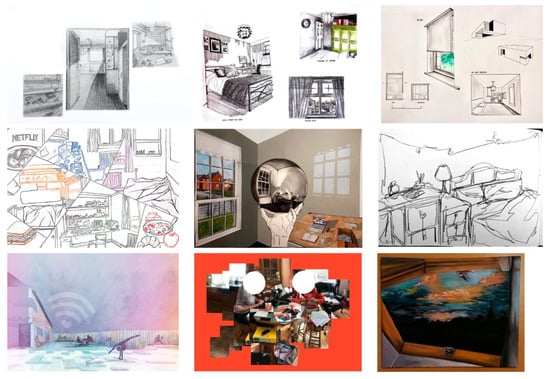
Figure 3.
Exemplary concepts of place during the period of the pandemic by first-year architecture students (Autumn 2020).
Weekly feedback sessions with students provide an educational setting for design thinking. Online, students engaged in critical debates about building designs, processes of production, and the impact architecture has on the built environment and its context. Instead of site visits in person, students were asked to survey sites for projects remotely, using online resources, such as digital Ordnance Survey maps, VU.City (3D digital planning and design tool) and Google Street view.
Once a project was complete, the Miro boards helped students reflect on their design process and understand their critical creative practices. Within the virtual design studio, students could now see their work alongside others in its entirety—from concept to final presentation. From a pedagogical perspective, Miro appeared to help students organise their teamwork, using post-it notes and messages to assign roles; they were able to develop the design through live discussions, using sketches, shared images and references.
The more successful teams were those who engaged with the technology and online peer-to-peer support. They openly shared information and communicated well online, e.g., by assigning a role to each person, and they utilised the technology in a light-hearted and creative way, providing friendly encouragement using notes and fun emojis.
4.3. Practical Skills Development and Digital Literacy in First-Year Architecture Studies
Practical skills development is a significant part of first-year architectural education, and a challenge with teaching practical skills is that it is predominantly an embodied practice completed in the physical studio space. To overcome a predicted deficit in skills and lack of a supportive conventional studio culture, the lecturers designed a series of task-based online skills workshops. This involved an hour-long introductory talk and instruction, followed by a postgraduate-led practical workshop (online). No doubt, adapting to VDS-based practical skills workshops caused stress and challenges for staff and individual students. However, lecturers were pleasantly surprised by the high level of peer encouragement and open sharing that took place during the online skills sessions between students and postgraduate helpers within the Teams chat function and the set-up using Miro boards (Figure 4).
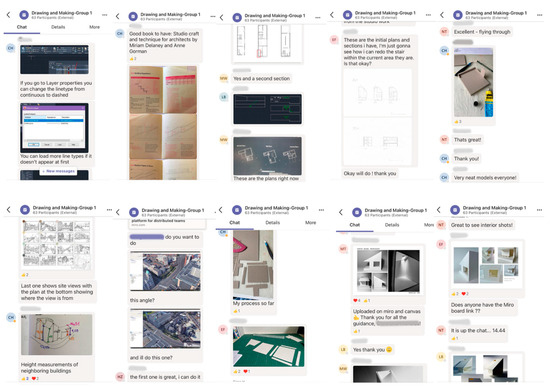
Figure 4.
Student interactions during online practical skills workshops via Teams (Spring 2021).
A new skill that was very successful was the integration of animation and filmmaking in design coursework. Animation was successfully used by one student when she overlaid sketches onto model photography to bring it to life and to think about the inhabitation of space (Figure 5). The film produced as part of one of the projects and developed by a group of students was an excellent example of how a film could capture the design process for the design of an outdoor classroom (Figure 6).
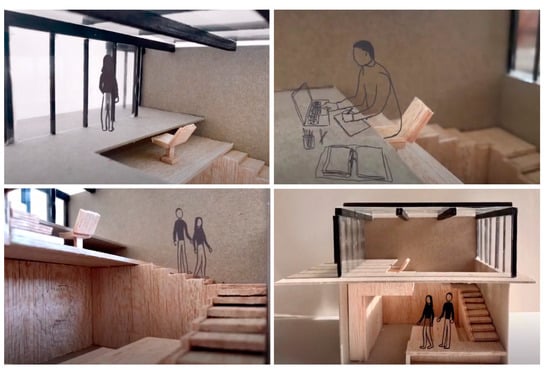
Figure 5.
Integrating digital technology into the early design stage. Student EH uses digital technology at the concept stage to explore the spatial qualities of a room, using scaled models and sketch animations (Autumn 2020).

Figure 6.
Students NC, AH, EH, DK, BZ, and AP documented the design process, from precedent research site analysis to final design (Spring 2021).
The pedagogical approach and integration of technology to enhance studio culture in a VDS can be summarised in the following diagram (Figure 7):
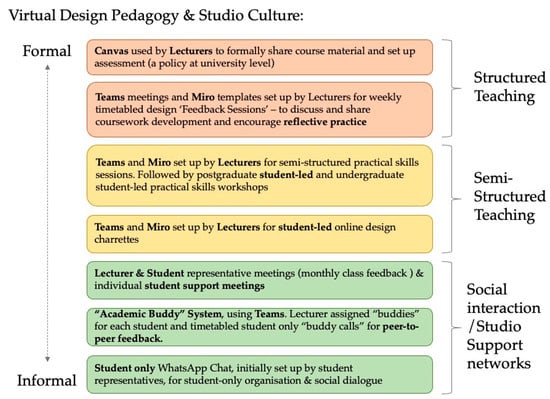
Figure 7.
Tools to enhance Studio Culture in a VDS. A range of formal and informal teaching methods were employed to scaffold online learning and enhance studio culture.
5. Student Experience
In order to explore students’ experiences of the studio culture during the pandemic, we distributed two questionnaires among the same cohort of students who commenced their architecture studies in September 2021. The first questionnaire was distributed to first-year students at the end of the academic year and asked the students specifically to reflect on the virtual design studio. Eighteen first-year students provided feedback, and the majority of the interviewed students stated that they felt part of the year group, noting also that they were in regular contact with colleagues outside of the structured feedback days during the period of the pandemic and virtual learning. These outcomes of the interaction among the students suggest that the use of interactive online tools helped in the creation of a ‘studio culture’ while physically distanced. The majority of the interviewed students enjoyed individual work and managing their own time during the same period and reported that they also felt comfortable with group work in a virtual design studio setting. Students were comfortable sharing their work with colleagues during structured tutorial days and noted that shared design feedback sessions were seen as an opportunity to learn from colleagues.
The second part of the questionnaire distributed to the students was with open-ended questions. Students commented on the aspects of individual work they enjoyed most during the virtual design studio, which include “being in control”, “learning up new software to aid in producing better quality work”, and “making my own decisions”, but also “experimenting”, “developing unique ideas” and “seeing everybody’s work”. Of the aspects of group work the students enjoyed the most during the virtual design studio, the students noted “learning of others”, “being in a team”, “getting to know people”, and “getting to converse with my peers”. Students also appreciated the “togetherness, sharing ideas, connection” and “the long calls and exchanging information”, as well as “sharing ideas getting to know each other”. When asked what is the biggest challenge of setting up a studio space within their own room during the period of the pandemic, the interviewed students commented that their own “space is too small” but also that there was “no interaction” and that they were “getting distracted easily”. One of the students commented that there was “no boundary between work and home” while working from home during the period of the pandemic. The biggest challenges for a virtual design studio and online studio/design teaching for first-year architecture students were that “communication is harder”, and the students expressed “feeling separated”. Challenges noted by the students include “getting distracted”, “lack of motivation”, and “time management and focus”. At the end of the first questionnaire, students were asked to compare their experiences of working individually to working in groups. One noted that “I feel I learn more when working individually, but learn faster when in groups”, while another noted that “you have more control over individual work; sometimes in group work your ideas are dismissed or not listened to”.
The second questionnaire, distributed to the same cohort of students in the subsequent academic year, asked the students to reflect on the biggest challenges they encountered during their first experience of face-to-face studio/design teaching and the conventional design studio. Students stated that time management is more of an issue; for example, one student commented: “Time management as now everything” when they referred to travelling from their home to class and between classes. Transitioning from online learning to in-person learning also appeared to cause social anxiety; students explained that they now needed to “learn how it all works in per- son”, “re-socialize” while another student found it “nerve racking” and the ”threat of COVID getting worse” (with the potential of another lockdown) appeared to add to stress and uncertainty.
Since the beginning of the 2021/22 academic year in the physical design studio, students have most enjoyed peer-to-peer support in the design studio. One student described the most enjoyable aspect as “working collectively in the studio and helping each other out”, while students agreed to “being able to ask for another opinion, or point of view”, and finding “inspiration from other students’ designs”. When asked to compare their individual experience of online teaching and face-to-face teaching, all interviewed students seemed to prefer face-to-face teaching and learning, stating that the “studio culture is a lot more comfortable and helpful” and that it felt more motivational, productive, and social. When talking to others, “you feel as if you’re not alone”, thus appearing to reduce feelings of isolation. One student reacted strongly against online teaching, stating that it is “awful” and that “online limits and feels unnatural thus stopping free flowing conversations”. While other students could see the benefits of both environments, stating that a “mix of online and in person” helps with time management and asynchronous learning.
6. Findings and Discussion
In this article, we explore the impact of online learning on first-year architecture studies and studio culture. The article follows a group of students who began their studies online in September 2020 and then transitioned, for the first time, to a face-to-face learning environment in September 2021. As discussed in Section 3.2, the CDS is synonymous with the cultivation of a ‘studio culture’ and is attributed to promoting a social and collaborative community. Blended approaches to CDS and VDS also provide evidence for fostering opportunities for collaborative learning, with varying degrees of success at different stages of a design project. With this in mind, we specifically explore the impact of VDS and the integration of digital technologies on architectural pedagogy and curriculum development during the pandemic. The researchers’ critical observations of teaching and the students’ reflective experiences of learning during the pandemic form the basis of critical reflection on studio culture in first-year architecture studies. At the start of the pandemic, lecturers were primarily concerned with adapting the CDS teaching method to an online environment whilst achieving all of the module learning outcomes, as required in the ARB and RIBA validation criteria. In addition, a significant challenge in the first year is cultivating a positive studio culture and the development of practical skills (e.g., hand drawing, orthographic drawing, and model making).
This research found that through the integration of technology, lecturers were able to explore new design methods that would not be possible with CDS. This included semi-structured online feedback sessions and skills workshops (for both analogue and digital skills), student-led design charettes, multiple ways to interact and collaborate through different platforms and settings, expedient information sharing, digitisation of the design process to enhance reflective practice, and asynchronous learning. As discussed in Section 4.3, the integration of digital technology was most successful when students adopted a hybrid approach to representing their ideas, communicating effectively in group work, sharing information, and representing their ideas through the creative use of media. The researchers also observed an unprecedented acceleration in digital literacy in the use of AutoCAD and Photoshop, which appeared to foster a higher level of confidence to support skills development.
The students’ feedback on their experience of online learning rendered mixed results and opinions. The most positive aspects of online learning appeared to be its transparency—seeing other’s work—and the ability to learn new software, helping to enhance student confidence and engagement. Negative aspects mostly related to social isolation, lack of motivation, and working in distracting spaces that were unfit for study.
This research found that it is possible to teach architecture online and to achieve the required learning outcomes for the first year of education. Compared to a CDS, it offers more opportunities for sharing information, simultaneous verbal and visual dialogues, expedient feedback, skills acceleration (especially digital literacy), and promotes creative design methods. However, during VDS, communication was harder, and it was necessary to take mediation measures to help cultivate a studio culture. From an academic perspective, the adapted curriculum and pedagogy were successful because all of the learning outcomes were addressed. However, challenges include social isolation, unfairness in terms of each person’s home studio environment, motivation, and confidence needed for real-world problem solving. In addition, transitioning from online learning to face-to-face presented further challenges in terms of settling into university life and learning a new form of embodied studio culture. The findings widened the scope for further curriculum development and highlighted a need to better understand the effectiveness of a VDS and the integration of technologies at an early stage of architectural education. To summarise, this research found that integrating technology allowed for new design methods, increased digital literacy and enhanced collaboration. While online learning achieved the required learning outcomes, it also presented challenges such as social isolation and motivation issues. The study highlights the need to better understand the effectiveness of virtual design studios (VDS) and technology integration in early architectural education, opening avenues for curriculum development and further research. The findings can offer insights to educators worldwide teaching first-year architecture students.
While we recognise the values associated with studio learning, the integration of technologies is necessary in facilitating different interactions and learning habits. Further studies should consider the impact of VDS on other year groups within architecture schools, as well as the application of different pedagogical methods within VDS.
Although the results presented are from a single country, the interviewed students come from different parts of the world. We believe that the presented study and the insights from both the lecturers and the students can provide some directions for future work for colleagues who are involved in teaching architecture to first-year students elsewhere as well.
Author Contributions
Conceptualization, J.M. and C.N.; methodology, J.M. and C.N.; formal analysis, J.M. and C.N.; investigation, J.M. and C.N.; writing-original draft preparation, J.M. and C.N.; writing-review and editing, J.M. and C.N.; visualization, J.M. and C.N. All authors have read and agreed to the published version of the manuscript.
Funding
This research received no external funding.
Institutional Review Board Statement
This study protocol was approved by the EPS Faculty Research Office of Queen’s University Belfast (EPS 21_85 on 22 March 2021).
Informed Consent Statement
Informed consent was obtained from all subjects involved in this study.
Data Availability Statement
The data are not publicly available due to privacy and ethical considerations.
Acknowledgments
We would like to thank the students in architecture at Queen’s University Belfast who participated in this study and whose experiences and direct observations are important in shaping architecture education in the future.
Conflicts of Interest
The authors declare no conflict of interest.
References
- Mishra, L.; Gupta, T.; Shree, A. Online teaching-learning in higher education during lockdown period of COVID-19 pandemic. Int. J. Educ. Res. Open 2020, 1, 100012. [Google Scholar] [CrossRef] [PubMed]
- Aguilera-Hermida, A.P.; Quiroga-Garza, A.; Gómez-Mendoza, S.; Del Río Villanueva, C.A.; Avolio Alecchi, B.; Avci, D. Comparison of students’ use and acceptance of emergency online learning due to COVID-19 in the USA, Mexico, Peru, and Turkey. Educ. Inf. Technol. 2021, 26, 6823–6845. [Google Scholar] [CrossRef] [PubMed]
- Paudel, P. Online education: Benefits, challenges and strategies during and after COVID-19 in higher education. Int. J. Stud. Educ. 2021, 3, 70–85. [Google Scholar] [CrossRef]
- Vowles, H.; Low, J.; Doron, H.R. Investigating architecture studio culture in the UK: A progress report. J. Educ. Built Environ. 2012, 7, 26–49. [Google Scholar] [CrossRef]
- Attoe, W.; Mugerauer, R. Excellent studio teaching in architecture. Stud. High. Educ. 1991, 16, 41–50. [Google Scholar] [CrossRef]
- Cuff, D. Architecture: The Story of Practice; MIT Press: Cambridge, MA, USA, 1991. [Google Scholar]
- Dutton, T.A. Design and studio pedagogy. J. Archit. Educ. 1987, 41, 16–25. [Google Scholar]
- Thoring, K.; Desmet, P.; Badke-Schaub, P. Creative environments for design education and practice: A typology of creative spaces. Des. Stud. 2018, 56, 54–83. [Google Scholar] [CrossRef]
- Turckes, S.; Kahl, L. Be a Teen Design Hero: 4 Lessons the Classroom Can Learn from the Design Studio. 2011. Available online: https://www.fastcompany.com/1665654/4-lessons-the-classroom-can-learn-from-the-design-studio (accessed on 21 September 2022).
- Corazzo, J. Materialising the studio: A systematic review of the role of the material space of the studio in art, design and architecture education. Des. J. 2019, 22 (Suppl. S1), 1249–1265. [Google Scholar] [CrossRef]
- Lawson, B. The Design Student’s Journey Understanding How Designers Think; Routledge: Oxon, UK, 2019. [Google Scholar]
- Anthony, K.H. Design Juries on Trial: The Renaissance of the Design Studio; Van Nostrand Reinhold: New York, NY, USA, 1991. [Google Scholar]
- Hettithanthri, U.; Hansen, P. Design studio practice in the context of architectural education: A narrative literature review. Int. J. Technol. Des. Educ. 2021, 34, 2343–2364. [Google Scholar] [CrossRef]
- Rodriguez, C.; Hudson, R.; Niblock, C. Collaborative learning in architectural education: Benefits of combining conventional studio, virtual design studio and live projects. Br. J. Educ. Technol. 2018, 49, 337–353. [Google Scholar] [CrossRef]
- Jones, D.; Lotz, N.; Holden, G. A longitudinal study of virtual design studio (VDS) use in STEM distance design education. Int. J. Technol. Des. Educ. 2021, 31, 839–865. [Google Scholar] [CrossRef]
- Rosa, C.; Ferreira, J. The distant studio: A survey of design students’ experience with distance educational formats. Int. J. Technol. Des. Educ. 2023, 33, 2019–2043. [Google Scholar] [CrossRef] [PubMed]
- Grover, R.; Wright, A. Shutting the studio: The impact of the Covid-19 pandemic on architectural education in the United Kingdom. Int. J. Technol. Des. Educ. 2023, 33, 1173–1197. [Google Scholar] [CrossRef] [PubMed]
- Megahed, N.; Hassan, A. A blended learning strategy: Reimagining the post-COVID-19 architectural education. Int. J. Archit. Res. Archnet-IJAR 2021, 16, 184–202. [Google Scholar] [CrossRef]
- Iranmanesh, A.; Onur, Z. Mandatory virtual design studio for all: Exploring the transformations of architectural education amidst the global pandemic. Int. J. Art Des. Educ. 2021, 40, 251–267. [Google Scholar] [CrossRef]
- Crowther, P. Understanding the signature pedagogy of the design studio and the opportunities for its technological enhancement. J. Learn. Des. 2013, 6, 18–28. [Google Scholar] [CrossRef]
Disclaimer/Publisher’s Note: The statements, opinions and data contained in all publications are solely those of the individual author(s) and contributor(s) and not of MDPI and/or the editor(s). MDPI and/or the editor(s) disclaim responsibility for any injury to people or property resulting from any ideas, methods, instructions or products referred to in the content. |
© 2023 by the authors. Licensee MDPI, Basel, Switzerland. This article is an open access article distributed under the terms and conditions of the Creative Commons Attribution (CC BY) license (https://creativecommons.org/licenses/by/4.0/).